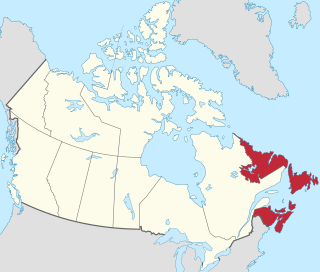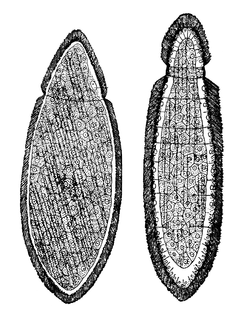
The Atlantic Ocean is the second-largest of the world's oceans, with an area of about 106,460,000 km2 (41,100,000 sq mi). It covers approximately 20 percent of Earth's surface and about 29 percent of its water surface area. It is known to separate the "Old World" from the "New World" in the European perception of the World.

The Atlantic slave trade, transatlantic slave trade, or Euro-American slave trade involved the transportation by slave traders of various enslaved African people, mainly to the Americas. The slave trade regularly used the triangular trade route and its Middle Passage, and existed from the 16th to the 19th centuries. The vast majority of those who were enslaved and transported in the transatlantic slave trade were people from Central and West Africa, who had been sold by other West Africans, or by half-European "merchant princes" to Western European slave traders, who brought them to the Americas. Except for the Portuguese, European slave traders generally did not participate in the raids because life expectancy for Europeans in sub-Saharan Africa was less than one year during the period of the slave trade. The South Atlantic and Caribbean economies were particularly dependent on labour for the production of sugarcane and other commodities. This was viewed as crucial by those Western European states that, in the late 17th and 18th centuries, were vying with each other to create overseas empires.

Atlantic Canada, also called the Atlantic provinces, a term developed for the convenience of the federal government after Newfoundland joined Canada in 1949, is the region of Eastern Canada comprising the four provinces located on the Atlantic coast, excluding Quebec: the three provinces of The Maritimes – New Brunswick, Nova Scotia, and Prince Edward Island – and the easternmost province of Newfoundland and Labrador. The population of the four Atlantic provinces in 2016 was about 2,300,000 on half a million km2. The provinces combined had an approximate GDP of $121.888 billion in 2011.

The east coast of the United States, also known as the Eastern Seaboard, the Atlantic Coast, and the Atlantic Seaboard, is the coastline along which the eastern United States meets the North Atlantic Ocean. Regionally, the term refers to the coastal states and area east of the Appalachian Mountains that have shoreline on the Atlantic Ocean, from north to south, Maine, New Hampshire, Massachusetts, Rhode Island, Connecticut, New York, New Jersey, Delaware, Maryland, Virginia, North Carolina, South Carolina, Georgia and Florida.

Qetesh is a goddess, who was adopted during the late Bronze Age from the religion of Canaan into the ancient Egyptian religion during its New Kingdom. She was a fertility goddess of sacred ecstasy and sexual pleasure, and became a popular deity.

Orthonectida is a small phylum of poorly known parasites of marine invertebrates that are among the simplest of multi-cellular organisms. Members of this phylum are known as orthonectids.

Astarte is the Hellenized form of the Ancient Near Eastern goddess Astoreth, a form of Ishtar, worshipped from the Bronze Age through classical antiquity. The name is particularly associated with her worship in the ancient Levant among the Canaanites and Phoenicians. She was also celebrated in Egypt following the importation of Levantine cults there. The name Astarte is sometimes also applied to her cults in Mesopotamian cultures like Assyria and Babylonia.

The Atlantic Coast Line Railroad is a former U. S. Class I railroad from 1900 until 1967, when it merged with long-time rival Seaboard Air Line Railroad to form the Seaboard Coast Line Railroad. Much of the original ACL network has been part of CSX Transportation since 1986.

The Slave Coast is a historical name formerly used for that part of coastal West Africa along the Bight of Benin that is located between the Volta River and the Lagos Lagoon. The name is derived from the region's history as a major source of Africans that were taken into slavery during the Atlantic slave trade from the early 16th century to the late 19th century. Other nearby coastal regions historically known by their prime colonial export are the Gold Coast, the Ivory Coast, and the Pepper Coast.

Zadig; or, The Book of Fate is a novella and work of philosophical fiction by the Enlightenment writer Voltaire. It tells the story of Zadig, a philosopher in ancient Babylonia. The author does not attempt any historical accuracy, and some of the problems Zadig faces are thinly disguised references to social and political problems of Voltaire's own day.
The Pantheon Range is a subrange of the Pacific Ranges of the Coast Mountains in British Columbia. It is located between the edge of the Chilcotin Plateau at Tatla Lake on its northeast and the Klinaklini River on its west, with a southeastern boundary along Mosley Creek, a major tributary of the Homathko River. The range is 5550 km2 in area and extremely rugged, with many sharp, glaciated peaks.
The Prix Rothschild is a Group 1 flat horse race in France open to thoroughbred fillies and mares aged three years or older. It is run at Deauville over a distance of 1,600 metres, and it is scheduled to take place each year in late July or early August.

Tokyo Red Hood is a Japanese manga written and illustrated by Benkyo Tamaoki. Its serialization began in the monthly Comic BIRZ in 2003. The manga is popular for its over-the-top gore and violence, and for the young main character and the different sex acts she partakes in.

Astartidae is a family of bivalves related in the order Carditida.
Astarte was an all-female black metal band from Athens, Greece, named after the goddess Astarte.

Astarte borealis, or the northern astarte, is a species of bivalve mollusc in the family Astartidae. It can be found along the Atlantic coast of North America, ranging from Greenland to Massachusetts.

Astarte elliptica, or the "elliptical astarte", is a species of bivalve mollusc in the family Astartidae. It can be found along the Atlantic coast of North America, ranging from Greenland to Massachusetts.
Astarte subaequilatera, or the lentil astarte, is a species of bivalve mollusc in the family Astartidae. It can be found along the Atlantic coast of North America, ranging from Labrador to Florida.

Astarte undata, or the waved astarte, is a species of bivalve mollusc in the family Astartidae. It can be found along the Atlantic coast of North America, ranging from Labrador to Maryland.















